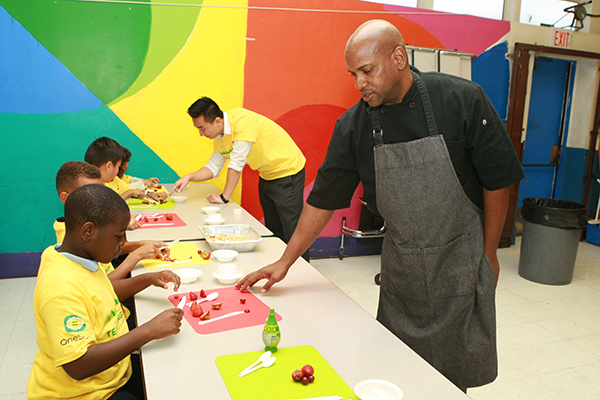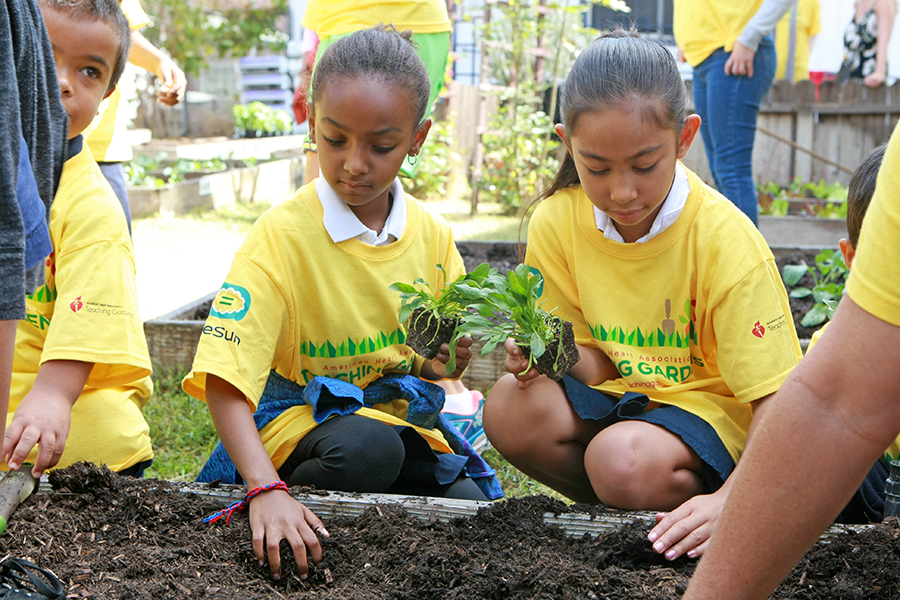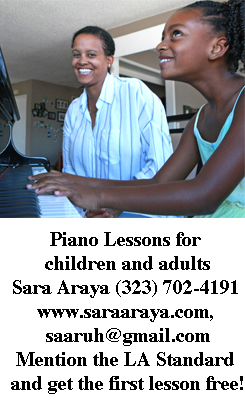The American Heart Association’s program has educated children about healthy diets by teaching them how to grow their own fruits and vegetables.

By Megan Reed
Processed foods have become a staple of the American diet over the past several decades, and with that came a number of health issues. Many people, especially children, are more likely to eat potato chips than actual potatoes. Junk food has become the norm because it’s so easily accessible, while fresh fruits and vegetables are typically not within hands reach.
The American Heart Association’s (AHA) Teaching Gardens program launched 10 years ago at Kelso Elementary School in Inglewood to teach children about the importance of eating healthy, and to show them how to do it. The program serves as a real-life laboratory for kids to learn to plant seeds, nurture growing plants, harvest produce and ultimately learn the value of good eating habits.
According to the AHA, since 1980 childhood obesity rates have tripled. The rate of obese six to 11-year olds has gone from six percent to 17.5 percent. The rate for teens has gone from five percent to 20.5 percent. For children ages two to five years old, 8.9 percent of them are obese today. These numbers are associated with poor diets.
“What we're doing is we're changing the environment and also educating young people about the importance of what they put in their body,” said Chef Bryce Fluellen, AHA’s instructor/educator for their Cook with Heart Los Angeles, Long Beach, and Santa Ana program. “So a garden not only creates that love for fresh whole food but it gives kids that opportunity to understand where food comes from.”
Processed foods is not going to be eliminated from the American diet, but through education, people can make better choices.
“One of the things it does is that when you grow a garden and you expose kids to fresh food it helps balance out the processed foods,” Fluellen said. “I don't think we'll ever eliminate processed fast food but what we want to do is get them to understand how great and how tasty fresh food is when you get it from the garden. And hope that they’ll start to consume more of that and start to limit the amount of fast and processed foods that they consume.”
One theory is that if the children participate in growing the food, they’ll be more likely to want to eat it.
“You can put out all of these great choices, but the children are going to want Cheetoes, just like I did when I was a kid,” said Anne Garrell, a retired teacher at Kelso Elementary School who volunteers with the gardening program. “But if they’re participating in the planting and the growing of the food, they’ll be more interested in eating it.”
The children who have participated in this program over the past 10 years have learned skills that they are able to take home with them.
“We had a lot of kids over the years go home and teach their parents, not only about food and food choices but also about gardening,” said Kelly Meyer, founder of the Teaching Gardens program.
It is feasible to have a home garden, even for people who live in an apartment.
“Seeds are inexpensive, and if you take care of your soil, you can grow a tremendous amount food for a very low cost,” Meyer said. “Pounds of food can come out of a garden. It does take resources to build a garden box and to buy the soil. But once you’re committed to it, it’s amazing.”
“We talked to a lot of the kids who live in apartments how even if you have a balcony or a porch you can get a container and grow a small thing of lettuce and some tomatoes,” Garrell said. “You don't need a yard or a huge amount of land to grow healthy food for yourself.”
According to the AHA, growing your own fruits and vegetables is surprisingly easy. City dwellers with access to sunlight for six hours a day, such as by a large window or on a balcony, can try container gardening. Buy a bag of weed-free potting soil and a couple of pots from a plant store, along with seed packets of fruits and vegetables you want to eat. Potatoes, chard, lettuce, cherry and bush tomatoes, peppers, eggplant and summer squash grow well in containers. And herbs are super easy to grow in containers on a windowsill.
For people who have a backyard, choose a spot that gets at least six hours of daytime light and has easy access to water.
Learning how to garden also helps children sharpen their skills from other classes at school.
“A lot of the teachers also use it for math,” Garrell said. “They figure out the area of the beds to figure out how much soil is needed. Some teachers come out and measure the plants and they track the growth.”
The Teaching Gardens program has built more than 400 gardens at schools around the country, with 55 of them in Los Angeles.
For more information about the Teaching Gardens program, and to find out how to bring the program to your child’s school, visit www.heart.org/teachinggardens.












